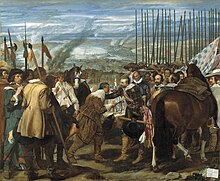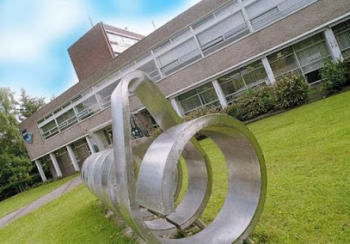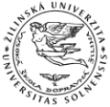Venue
| Breda | |||
|---|---|---|---|
| City and municipality | |||
 Docks in the city centre | |||
|
|||
 Location in North Brabant
|
|||
| Coordinates: 51°35′N 4°47′E / 51.583°N 4.783°E Coordinates: 51°35′N 4°47′E / 51.583°N 4.783°E | |||
| Country | Netherlands | ||
| Province |
|
||
| Website | www |
||
Breda (Dutch pronunciation: [breːˈdaː]
(
![]() listen))
is a city and
municipality in the southern part of the
Netherlands, located in the province
of North Brabant. The name derived from brede Aa ('wide Aa' or 'broad Aa') and refers to the confluence of the rivers
Mark and Aa.
[7]
listen))
is a city and
municipality in the southern part of the
Netherlands, located in the province
of North Brabant. The name derived from brede Aa ('wide Aa' or 'broad Aa') and refers to the confluence of the rivers
Mark and Aa.
[7]
As a fortified city, it was of strategic military and political significance. Although a direct Fiefdom of the Holy Roman Emperor, the city obtained a municipal charter; the acquisition of Breda, through marriage, by the House of Nassau ensured that Breda would be at the centre of political and social life in the Low Countries. Breda had a population of 183,456 in 2017; the metropolitan area had a population of 324,812. It is part of the Brabantse Stedenrij.
History[ edit]
In the 11th century, Breda was a direct fief of the Holy Roman Emperor, [7] its earliest known lord being Henry of Brunesheim (1080–1125). The city of Breda obtained a municipal charter in 1252. After that Breda had the rights to build fortifications. The city constructed brick walls and Roman-style gates.
|
In 1327 Adelheid of Gaveren Breda sold Breda to Duke Johannes III of Brabant. In 1350, the fief was resold to Johannes II of Wassenaar (d. 1377). In 1403 the heiress of his line, Johanna of Polanen (1392–1445), married Engelbert I of Nassau (1370–1442) (his sarcophagus is in the Grote Kerk in Breda). Through her, the city came into the possession of the house of Nassau, where it remained until 1795, passing to William I of Orange (1533–1584), stadtholder of Holland, Zeeland, and Utrecht and leader of the Dutch revolt. Thus, the baron of Breda was also Count of Nassau in the Holy Roman Empire, Prince of Orange, and stadtholder of the Dutch Republic (from 1572–1650, 1672–1702, 1747–1795). Breda remained part of the barony of Breda until it was captured by French revolutionary forces in 1795. [8] |
|
||||||||||||||||||||||||
Residence city[edit]
The acquisition of the city by the House of Orange-Nassau marked its emergence as a residentiestad (residence city). The presence of the Orange-Nassau family attracted other nobles, who built palatial residences in the old quarters of the city. The most impressive one, built by the Italian architect Thomas Vincidor de Bologna for the first Dutch prince, was the first renaissance-style palace built north of the Alps. In the 15th century the city's physical, economic and strategic importance expanded rapidly. A great church was built in Brabantine Gothic style with a gallant 97-metre-high (318 ft) tower, called Grote Kerk (main church) or also Onze Lieve Vrouwe Kerk (Church of Our Lady). In 1534 Henry III of Nassau-Breda rebuilt the modest medieval fortifications in impressive style.
|
In 1534 a fire destroyed over nine tenths of the city, close to 1300 houses, churches, and chapels, and the town hall. Only 150 houses and the main church remained. In July 1581, during the Eighty Years' War, Breda was captured in a surprise attack and siege by Spanish troops then under the command of Claudius van Barlaymont, whose sobriquet was Haultpenne. Although the city had surrendered upon the condition that it would not be plundered, the troops vented their fury upon the inhabitants. In the resulting mayhem, known as Haultpenne's Fury, over 500 citizens were killed. In March 1590, Breda fell back into the hands of the Dutch and Maurice of Nassau, when a 68 men hand-picked force, concealed under the turf of a peat-boat, had contrived to enter the city in a daring plan devised by Adriaen van Bergen (Siege of Breda (1590)). Around 1610 the construction of the Spanish Gate or "Spandjaardsgat" was started as a remembrance to that successful action[9]. |
|

Surrender of Breda, by Diego Velázquez. |
After a ten-month siege in 1624–25, the city again surrendered to the Spaniards, now led by Spinola; the event was immortalized by Diego Velázquez. In the Siege of Breda of 1637 the city was recaptured by Frederick Henry, Prince of Orange, after a four-month siege, and in 1648 it was finally ceded to the Dutch Republic by the Treaty of Westphalia. In 1646, Frederick Henry founded the Orange College of Breda, modelled on Saumur, Geneva, and Oxford, intending it to train young men of good family for the army and the civil service.[10] |
Stuart exiles[edit]
The exiled Stuart Charles II of England resided in Breda during most of his exile during the Cromwellian Commonwealth and Protectorate, thanks to the proximity of Charles's sister Mary, Princess Royal and Princess of Orange, the widow of Prince William II of Orange (died 1650).
Based mostly on suggestions by the Parliamentarian General George Monck, Charles II's Declaration of Breda (1660) made known his conditions for accepting the crown of England, which in the event he was to regain a few months later in the year.
Later history[edit]
The Treaty of Breda was signed in the city on 31 July 1667, bringing to an end the Second Anglo-Dutch War in which the Dutch faced the same Charles II who had been their guest. Between 1746 and 1748 it was the site of the Congress of Breda, a series of talks between Britain and France aimed at bringing an end to the War of the Austrian Succession, which ultimately led to the signing of the Treaty of Aix-la-Chapelle.
 Polish soldiers welcomed by the residents of Breda, 1944 |
During the Second World War, the city was under German occupation. It was liberated following a successful outflanking manoeuvre planned and performed by forces of 1st Polish Armoured Division of General Maczek on 29 October 1944. Each year during Liberation Day festivities, Breda is visited by a large Polish contingent and the city of Breda reserves a special portion of the festivities for the fallen Polish soldiers. A museum and a monument honoring Maczek and the Polish 1st Armoured Division stands in the city center. General Maczek and many soldiers of his division are buried in the nearby Polish military cemetery. Breda was the site of one of the first panopticon prison establishments, Koepelgevangenis. This prison housed the only German war criminals ever to be imprisoned in the Netherlands for their war crimes during the Second World War. Known as the Breda Four, or "Vier von Breda", they were Willy Paul Franz Lages, who was released in 1966 due to serious illness, Joseph Johann Kotälla, who died in prison in 1979, and Ferdinand aus der Fünten and Franz Fischer, who were both released in 1989 and died later the same year. |
Main sights[edit]
The city center contains old buildings and portions of the singels (moats) and the harbour. Focal point is the Grote Markt, the main square with pubs and sidewalk cafes.
Park Valkenberg is a major public park, halfway between the main railway station Breda and the Grote Markt.
Major historic buildings include:
- The Grote Kerk (Great Church) or Onze Lieve Vrouwe Kerk (Church of Our Lady), a major example of the Brabant style of Gothic Architecture.
- The Castle of Breda.
- The Begijnhof, a Beguinage.
- Saint Anthony's Cathedral (Sint-Antoniuskathedraal), the cathedral church of the Catholic Diocese of Breda.
- City hall.
- The Spanjaardsgat, a 16th-century water gate.
 Museum of the Image (MOTI) |
Museums[edit]
Breda hosts the following museums:
- Begijnhof Breda Museum
- Generaal Maczek Museum
- Bier Reclame Museum
- NAC Museum
- Heemkundig Museum Paulus van Daesdonck
- Stedelijk Museum Breda
- Stichting Princenhaags Museum
Parts of this text and pictures were copied from 
Conference Venue - BEWARE THE CONFERENCE HAS BEEN MOVED TO ANOTHER UNIVERSITY BUILDING

|
|
Getting to Breda and Breda University of Applied Sciences 
By Plane




|
When arriving by plane in the Netherlands, you will either land at Schiphol Airport in Amsterdam,
Rotterdam - The Hague Airport
or Maastricht - Aachen Airport.
From Schiphol Airport you can take either a train or bus to Breda.
From Rotterdam - The Hague Airport you can take a metro and a train to Breda.
From Maastricht - Aachen Airport you can take a bus and a train to Breda. |
By Train 
|
Breda has two railway stations, Breda and Breda-Prinsenbeek, providing connections with Zuid-Holland (Dordrecht ‐ Rotterdam ‐ Den Haag) and Tilburg ‐ Eindhoven, and from station Breda also to Roosendaal with connection to Vlissingen and Antwerp. In addition, trains also head north from Breda to Amsterdam and east to Den Bosch ‐ Nijmegen. Breda Oost railway station will open after 2020. You can prepare your train journey using this NS Link. |
By Bus |
Buses are operated by Arriva. There are four kinds of buses in Breda: citybuses, regional, Bravodirect and long-distance. Citybuses drive only within Breda (sub-12 numbers), regional buses provide connections to nearby towns and cities, Bravodirect buses are more luxurious buses driving to Etten-Leur and Oosterhout (31x and 32x-buses), and long-distance 'Brabantliners' connecting both Gorinchem and Utrecht with Breda (401, 402). There is also one Zeelandish busline (19) which connects Breda with Hulst and Antwerp, operated by Connexxion. From further afield you can reach Breda by bus from Eurolines. |
By Taxi |
Breda University of Applied sciences is easily reachable by taxi.
|
By Car |
The A16 is a motorway to the north to Rotterdam and towards the south to the Belgian border to Antwerp. The A27 is also a motorway to the north; It connects Breda with Utrecht. Furthermore, The A58 connects Breda with Tilburg and Eindhoven. |
On Foot
|
All chosen hotels are within easy walking distance of Breda University of Applied Sciences. (see hotel page) |
Breda University of Applied Sciences Location Maps















